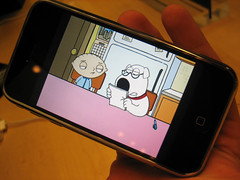When you are fully occupied with a production of an event, it is sometimes extremely useful to take a moment or two to reflect things. On Friday and Saturday I attended an academic conference by the Amsterdam-based Institute of Network Cultures on artistic responses to YouTube called Video Vortex. Here's a short summary on the main ideas I came out with:
1. It is not all art: Many of the speakers started by defining YouTube. However I felt at times that there was a tendency to try to interpret the entire YouTube archive within the context of arts and creativity which to me seemed a bit like trying to explain a railway station within the context of galleries. In my own project I want to address this complexity by providing multiple explanations for the videos shown - I mean not only "fruit of one's creativity" but also results of boredom, school assignments and pure fun.
2. It is not all bad: Tilman Baumgärtel spoke well about the impact of piracy in South-East Asia. He explained how the pirate DVDs are in many ways a tool for film fans in the region to get hold of indie productions from other continents and that the pirate distribution is more and more a conscious distribution channel for local independent film makers. The most interesting thing was his research on how the DVDs get to the Philippines. As he pointed out, we are not talking of illegal downloads or professional mafia distribution chains, we are talking of women from mainland China carrying the master copy in their bag or fishermen hiding the mastercopies into the stomachs of tunafish on their boat trips from Malaysia.
Piracy as a distribution chain is something I also saw in Turkey a while back. I was taken to a store with collections of Hal Hartley, Antonioni,von Trier, Bergman and what have you. And as the local people told in Turkey and also according to Baumgärtel in Philippines, they don't really download their films but they trust their local dealer who has good taste.
3. Size does matter: Andreas Treske spoke well about the changes of the viewing experience when we go from not only seeing films in cinemas but also watching TV shows and even films on our iPhones. It was fascinating how he demonstrated how in the cinema the film has our undivided attention but on the iPhone screen the film in a way fights with the background and all the things around us.
His presentation made me think a lot about how online video should be curated. Is it actually good to stay close to the screen size that the films were made for and what do we lose if you blow a YouTube video on a gigantic screen?
Taktik Menyerang yang Sering Digunakan Pelatih
11 hours ago













No comments:
Post a Comment